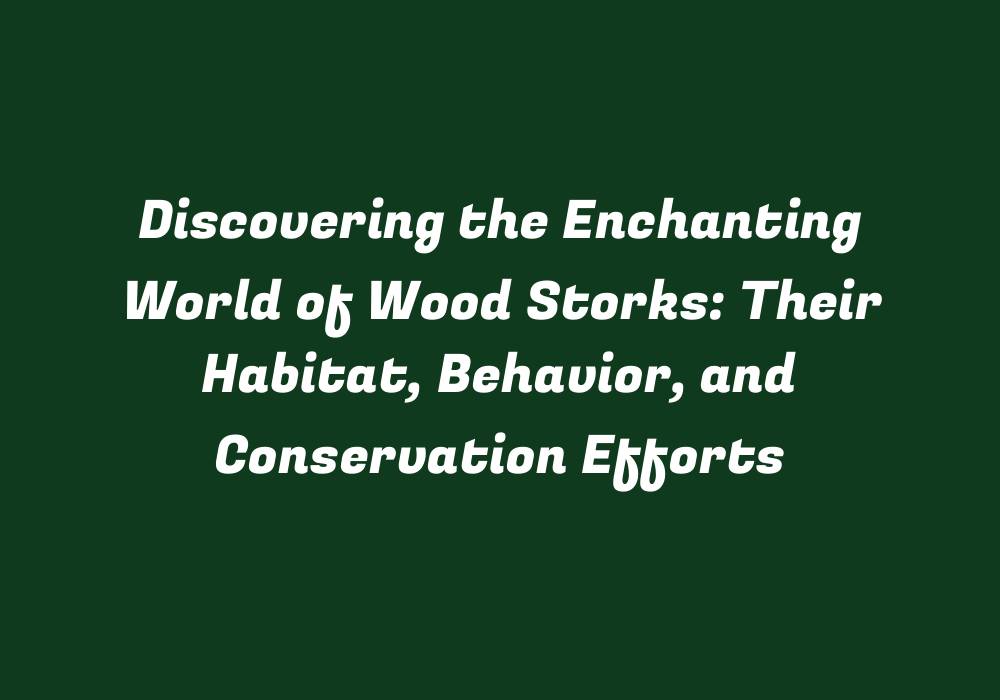Introducing Wood Storks: A Glimpse into Their Enchanting World
Wood storks are a unique species of bird native to the United States and parts of Central America. These wading birds are known for their striking appearance, distinctive behavior, and crucial role in maintaining ecosystem balance. This article takes an in-depth look into their habitat, behavior, and efforts being made towards conserving this important bird species.
Exploring Their Habitat
Geographical Distribution: Wood storks inhabit a specific geographic area, with the majority residing in Florida’s Everglades and the lower southeastern United States. Smaller populations can also be found in parts of Central America like Costa Rica and Panama. They prefer areas near water bodies, such as freshwater marshes, swamps, and estuaries.
Preferred Habitat Conditions: Wood storks are well-adapted to their unique habitats. They select locations with the right combination of shallow freshwater areas for feeding, open woodlands or palm forests for roosting, and sandy beaches for nesting purposes. These birds require a good balance between water bodies, trees, and nesting sites to thrive.
Understanding Wood Stork Behavior
Feeding Behavior: As wading birds, wood storks primarily forage in shallow water where they can use their long, down-curved bills to catch fish and amphibians. They hunt using a technique known as “fishing by sight,” where they search the water’s surface and edges, watching for movements of potential prey. Wood storks also feed on aquatic insects and occasionally small mammals.
Social Behavior: Wood storks are gregarious birds that often congregate in groups called colonies. These social gatherings provide opportunities for nesting, roosting, and mating activities. During the breeding season, wood storks engage in elaborate courtship rituals, which include preening each other’s feathers, dancing, and vocalizing to establish bonds and attract potential mates.
Nesting Behavior: Wood storks build nests in tall trees or large shrubs near water sources. They use sticks, twigs, and branches to construct a platform nest. Females lay between two and four eggs, which they incubate for approximately 30 days. Both parents take turns feeding the chicks regurgitated food until they fledge around 85-120 days post-hatching.
Migration Patterns: Wood storks are non-migratory birds, meaning they do not travel long distances in search of better habitat. They have a home range within their native habitats and usually stay there year-round. However, during periods of drought or extreme weather conditions, wood stork populations may move to different locations for temporary food sources.
Conservation Efforts for Wood Storks
Threatened Species: Despite being a federally protected species in the United States, wood stork numbers have declined significantly over the past century due to factors such as habitat loss, pollution, and human interference. Their unique habitat requirements make them particularly vulnerable to changes in their environment.
Conservation Strategies: Various conservation strategies are being employed to protect wood storks and ensure the continuity of their species. These include:
1. Habitat Restoration: Efforts are made to restore and maintain suitable habitats for wood storks by removing invasive species and planting native vegetation.
2. Nesting Site Management: Protective measures, such as fencing or nesting platforms, are utilized to safeguard nests from predators and potential threats like development projects.
3. Environmental Monitoring: Regular monitoring of water quality, fish populations, and other environmental factors helps identify potential issues that may impact wood storks and their habitats.
4. Education and Public Awareness: Raising public awareness about the importance of preserving this unique species is crucial in fostering support for conservation efforts.
5. Collaborative Efforts: Conservation groups, local authorities, and organizations work together to develop comprehensive management plans that address various challenges facing wood storks and their habitats.
In conclusion, understanding the behavior of wood storks is essential for preserving this captivating species. By recognizing their habitat needs and unique behaviors, we can take steps to conserve them and ensure they continue to play their vital role in maintaining ecosystem balance.
Conclusion
Wood storks are not only fascinating creatures but also crucial for the delicate balance of their native habitats. By exploring their habitat, behavior, and understanding their conservation needs, we can work towards protecting these beautiful birds. The combination of proper management, environmental protection, public awareness, and collaboration among various entities will be crucial in preserving the enchanting world of wood storks for future generations to enjoy.
To sum up, it is vital to appreciate the importance of these wading birds and take action to ensure their long-term survival. By recognizing the need for their conservation and working together as a community, we can help protect this unique and captivating species for years to come.
